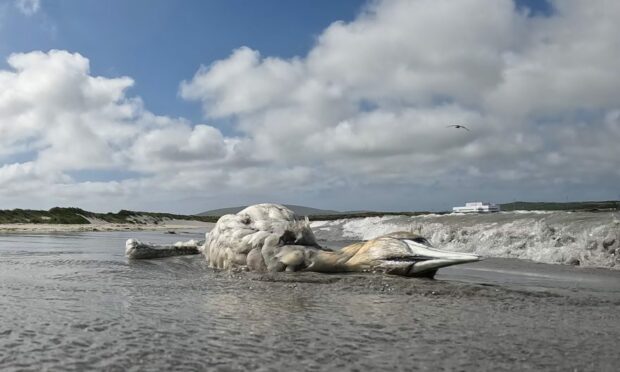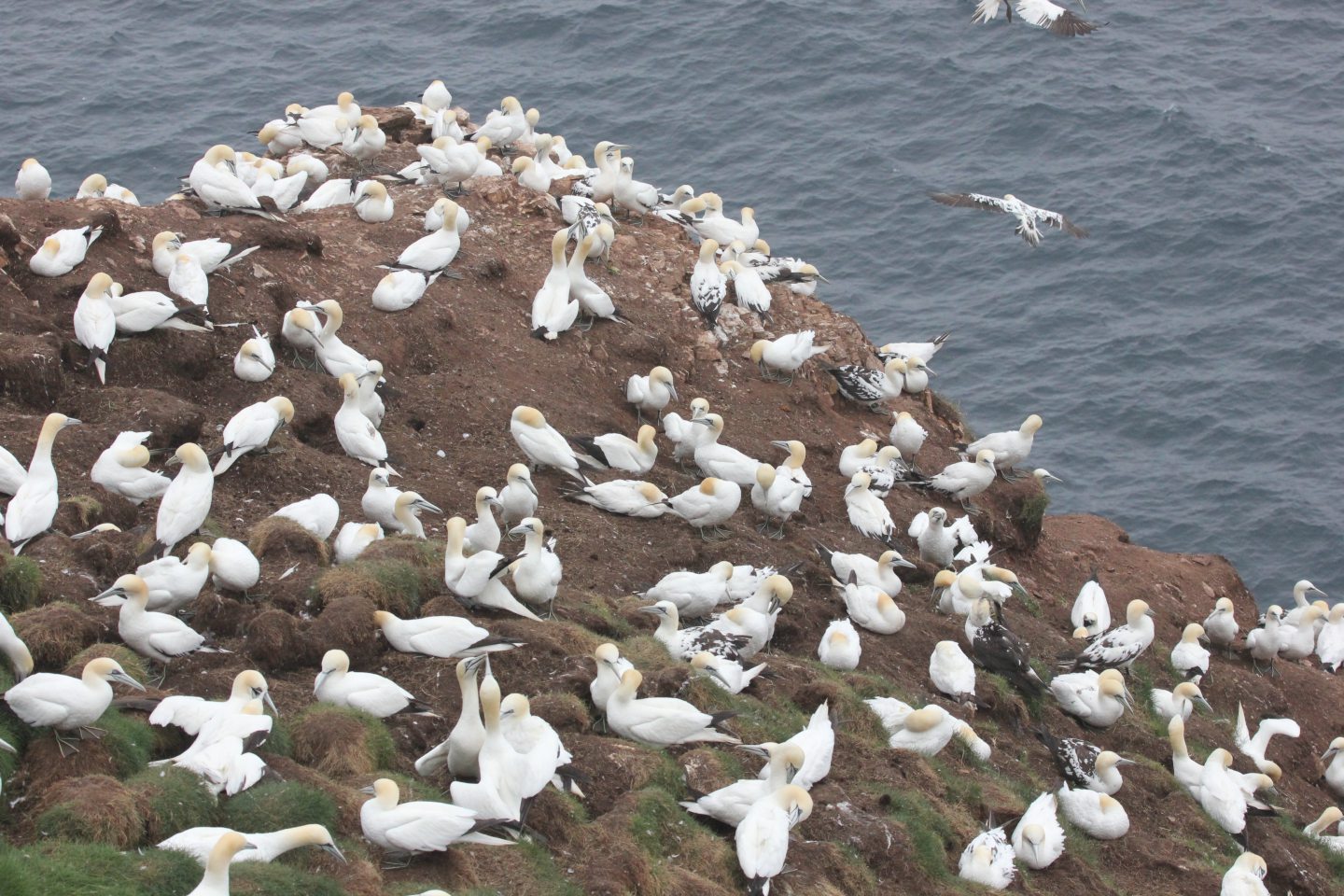The impact of bird flu is no longer hidden away along remote coastal cliffs as beach walkers all across the north, north east and islands are stumbling across hundreds of dead birds much closer to home.
Popular beaches like Cruden Bay and St Cyrus in Aberdeenshire and Brora and Lybster further north are littered with the bodies of dead and dying seabirds washing ashore.
The birds are thought to be dying of avian flu which appears to be spreading rapidly through colonies after a significant number of cases were first detected earlier this year.
We spoke to four people across the north and north east who have been highlighting the tragedy by sharing their photographs and videos on social media.
‘No-one is picking up the bodies’
Twitter has been a popular place for members of the public to share the horrific scenes they have been coming across on beaches.
Peter Stronach is a professional wildlife photographer and ecologist and has been documenting the crisis on social media since the spring.
I could just about cope when it was adults washing up on the beaches, but now it's fledglings lying dead alongside their fathers! 343 Guillemots on Brora beach last night, including 19 fledglings… #avianflu pic.twitter.com/Ak0JJtI4VH
— Peter Stronach 🦅🐳🐝🌲 (@macstronach) July 3, 2022
He raised the alarm to DEFRA after 350 dead and dying birds were found at Brora Beach this week and says no one yet knows what to expect in terms of casualties but the spread is continuing.
He said: “What I would like to see is all these carcasses taken off the beach to prevent spread to other species like scavengers like raptors and gulls and also to remove risk of it getting passed to people.
“Studies show that the virus can persist in feathers of a dead bird for 160 days in certain conditions.”
At the moment, the bodies of dead birds are not being removed from beaches in any organised way.
New figures show 492 wild birds have tested positive for the highly pathogenic avian influenza H5N1 (HPAI) in more than 100 locations and covering 26 species.
The RSPB said the virus’s ability to spread to 26 recorded species including razor bills, puffins, and birds of prey, shows it is “incredibly virulent”.
Brora, Sutherland: Guillemots and Gannets
Heartbreaking to see so many on the beach at Dalchalm, Brora. Mixture of gannets and guillemots. People passed by, not wanting to look. Understandable, but we need to face the shit we've created.
— MaggieMcGou (@MaggieGou) July 4, 2022
Orkney resident Maggie McGou was visiting Brora this week when she and her husband saw a couple of gannets collapsed and convulsing in the sand.
Their first thought was to call for help, but after counting 20 gannets and guillemots on a short stretch of beach they realised “there were too many” to help.
Maggie said: “So many people were just turning away and carrying on as normal but we simply couldn’t believe what they were seeing.
“The gannets in particular shocked us because they are so majestic and huge.
“We didn’t know what to do, we just had to leave them, but when we went back the next day some were still alive, still in agony.
“I just wanted someone to come and put them out of their misery.”
Newburgh in Aberdeenshire: Bird flu having a ‘hellish impact’
This afternoon, in a 2 mile stretch of beach at Newburgh, Aberdeenshire I collected 40-50 gannets, 15-20 guillemots, a few razorbills and gulls. All ages including this recently fledged young guillemot 😪. This avian flu is having a hellish impact on our seabirds pic.twitter.com/J3JvWSVgkq
— Ron Macdonald (@ronpon_ron) July 2, 2022
Wildlife photographer Ron Macdonald previously worked for Scotland’s nature agency, Nature Scot.
Now retired, he chairs the North East Biological Records Centre and serves on the Scottish Wildlife Trust’s Conservation Committee.
As a result, he’s very knowledgeable about bird species in the region and has been tracking suspected avian flu deaths in the north east.
Tarbat Ness in Ross Shire: ‘Dead, dying or very sick birds’
Another sad and somewhat depressing morning at Tarbat Ness witnessing the ravages of the aftermath of Avian Flu. At least 17 individuals (of just 2 species Gannet – 2 & Guillemot – 15) either dead, dying or very lethargic/sick. @DefraGovUK @ScottishEPA #highlandbirds @rothiemoon pic.twitter.com/hzsMzEsmuw
— Dave Tanner (@TarbatNess99) July 2, 2022
Dave Tanner is a birdwatcher who lives at Portmahomack and records his daily sightings from Tarbet Ness for the British Trust for Ornithology’s BirdTrack Migration Blog.
A keen ‘amateur birder’ since the 50s, Dave has never seen bird deaths on this scale and has been documenting the issue on Twitter to spread the word.
He gets “frustrated and emotional” and wants to lash out at the government but believes they are overwhelmed by the disaster.
“The sad thing is it’s such an end game for the birds that get it, there’s nothing that you can do about it – bird flu arrives and it is just decimating, and like Covid, there is no cure,” he said.
Cromarty Firth: A glimmer of hope?
Bob Swann, the British Trust Ornithology’s representative for the Small Isles, monitors bird populations at Caithness and on the cliffs at North Sutor on the Cromarty Firth.
His surveys show North Sutor has lost a third of its guillemot population while other species are “doing okay” which is giving him hope.
Looks like bird flu is now affecting Guillemots. Birds being washed up on beaches from Dornoch to Berriedale, including 4 adults ringed on Caithness Cliffs. Also BTO has just reported TEN adult birds from North Sutor recently found dead on Moray Firth beaches. pic.twitter.com/frjk7daJCj
— Bob Swann (@SwannBob) June 7, 2022
Despite this, Bob said it’s clear that the disease spreads fast between species as although guillemots are predominantly affected in the Cromarty Firth, birds nesting near them, like cormorants, have also been suffering.
Bob suspects the 350-or-so guillemots and gannets at Brora came from the RSPB’s Troup Head Nature Reserve near Banff where sick and dead gannets have also been found.
He added: “I know it would be a massive operation but it would be ideal if the carcasses could be removed because when they are just left on the beach other species come in and can easily pick up the disease.”
What should I do if I see any dead or dying birds?
Transmission to humans is rare but the advice is stay away from the birds and keep your pets away from them as they may be infected with bird flu.
Phone the Department for Environment, Food and Rural Affairs (DEFRA) on 03459 33 55 77.


Conversation